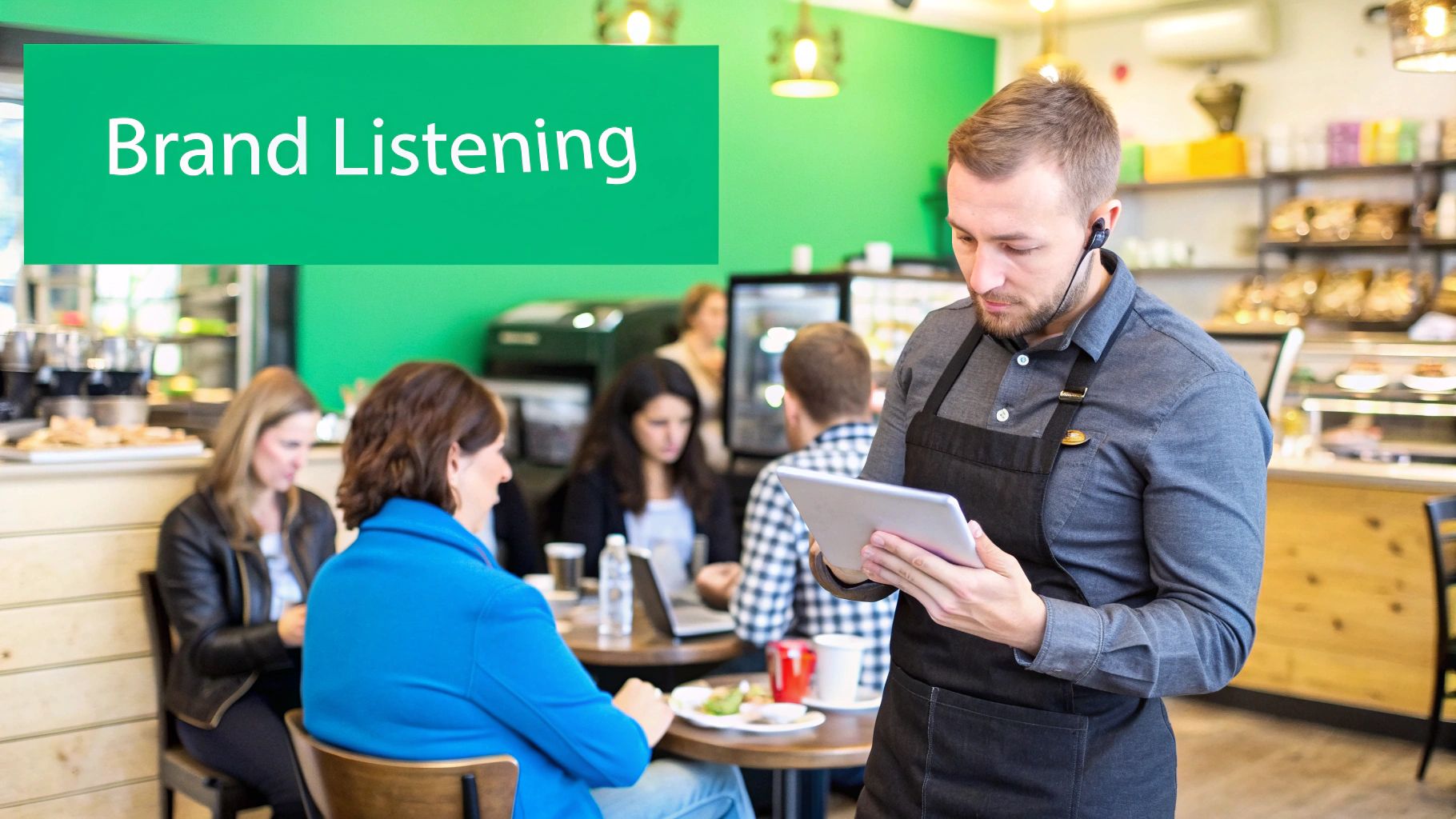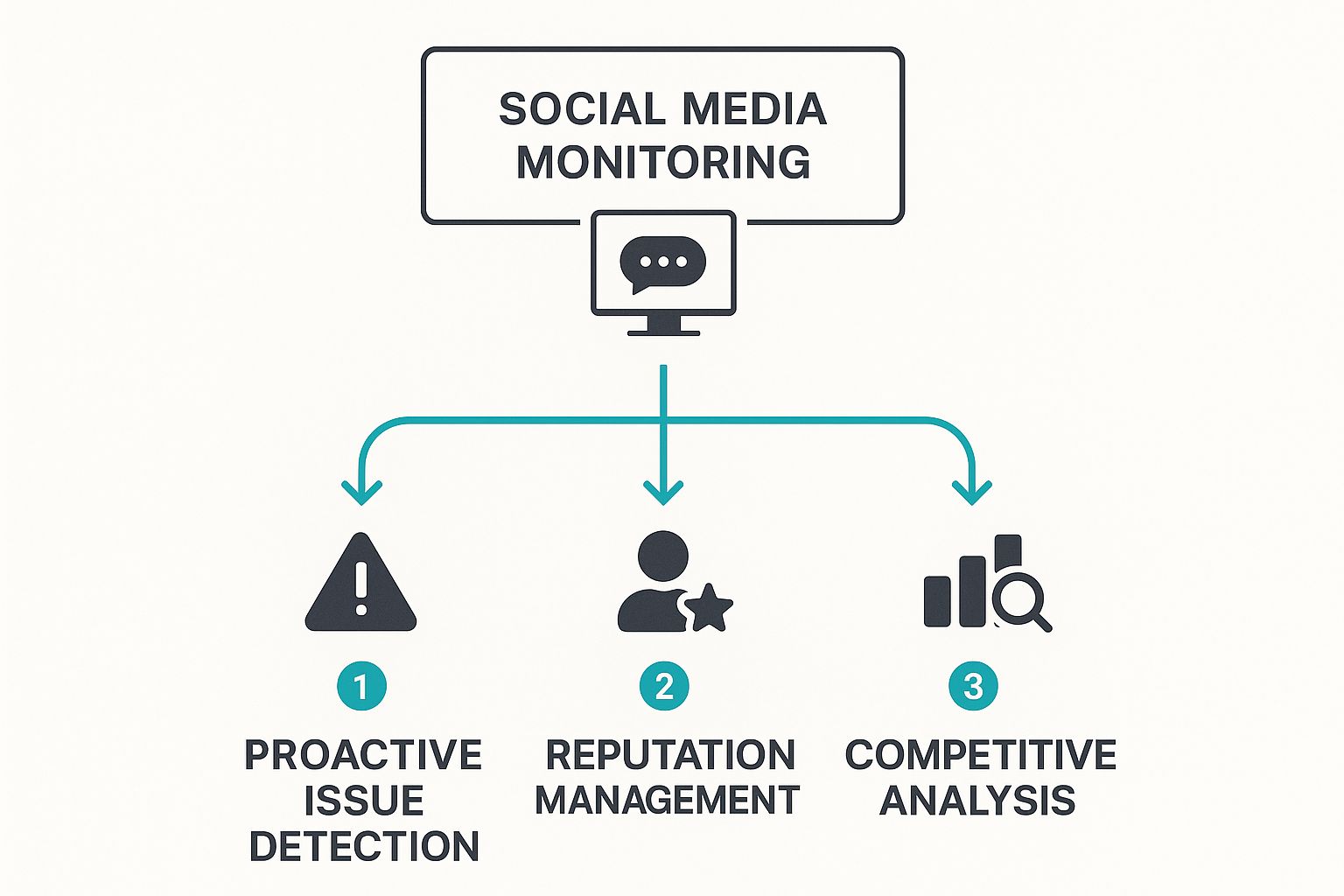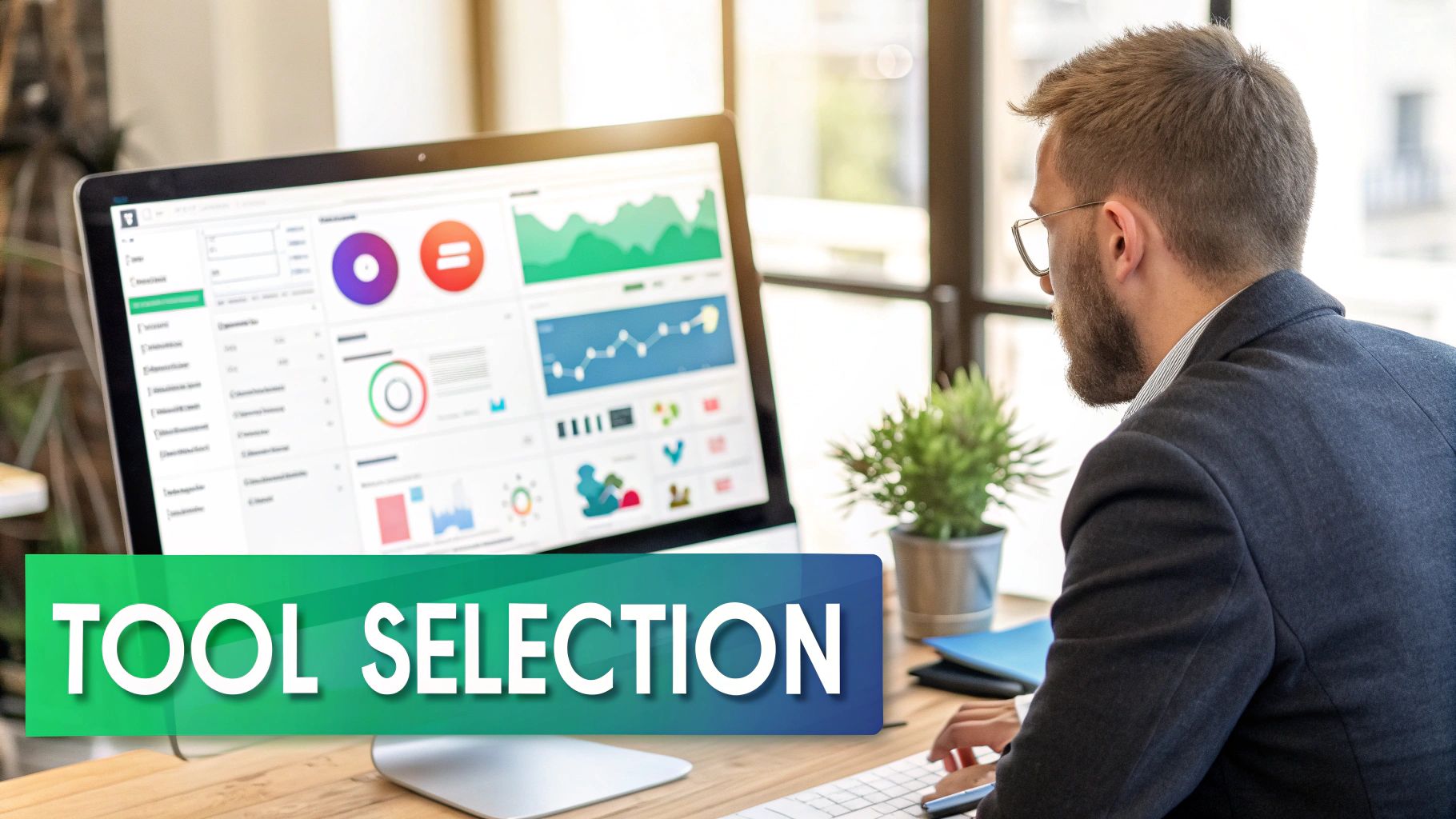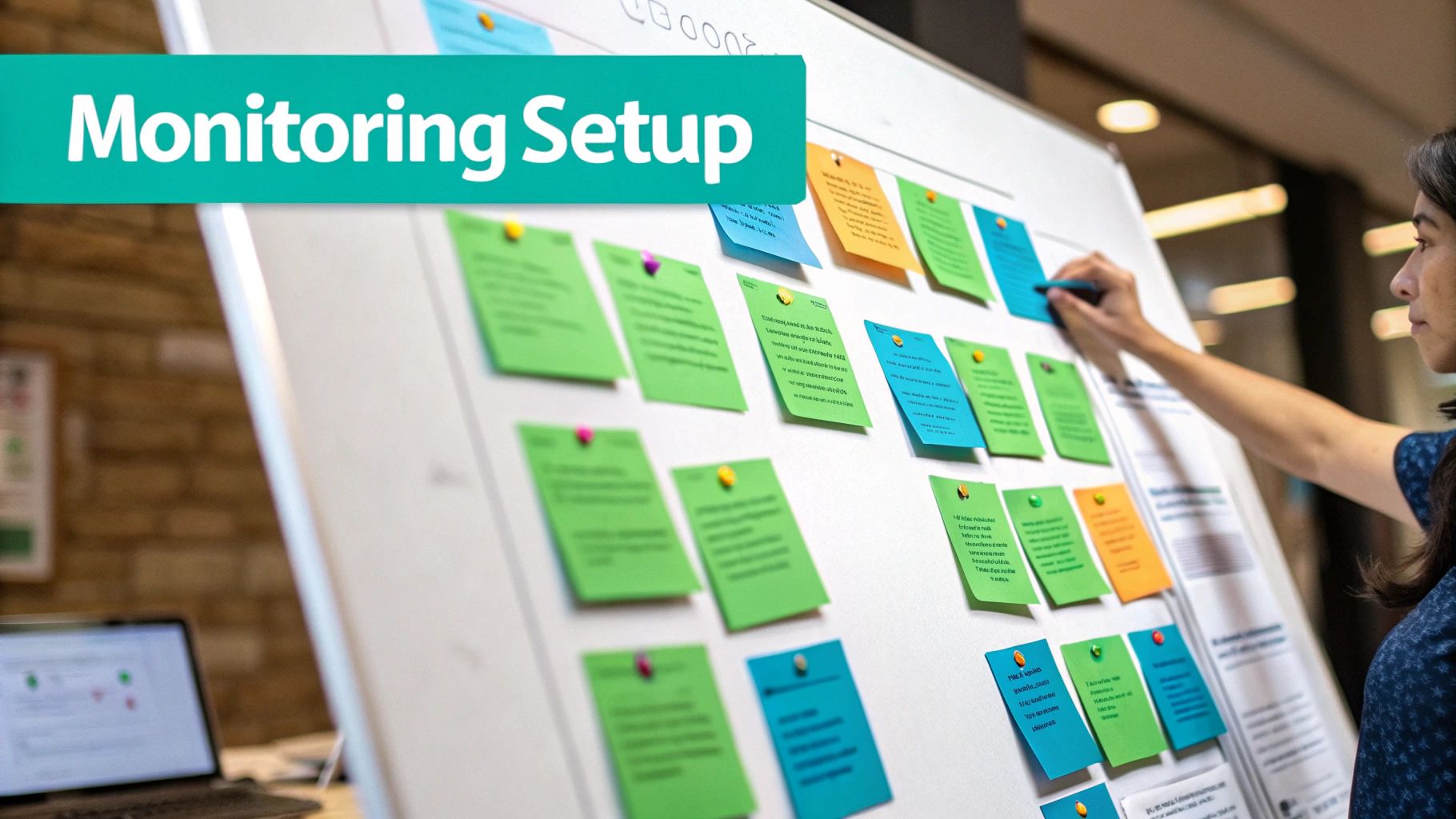What is Social Media Monitoring? Boost Your Business Today
Social media monitoring is really just the art of tuning into the digital chatter about your brand. It’s how you systematically track what people are saying online about you, your competitors, or your industry across platforms like X (formerly Twitter), Facebook, and Reddit to get a real-time pulse on public perception.
A New Set of Ears for Your Business

Think of your business as a busy café. You can hear what customers at the counter are saying, no problem. But what about the folks in the corner booth? Or the conversation happening at the coffee shop across town mentioning your brand? Social media monitoring gives you an incredible set of ears, letting you tune into every discussion about your brand, not just the ones happening right in front of you.
This isn’t about some overly complex technology; it’s about smart business intelligence. You’re simply keeping an eye on mentions, keywords, and hashtags to get the full picture of your online footprint. To really get a handle on it, it's worth exploring the fundamental definition of social media monitoring.
The Core Monitoring Loop
Good monitoring isn't a passive activity where you just collect data. It's an active cycle that helps you make smart moves. It usually boils down to a simple, powerful loop:
- Track: Systematically find and gather mentions of your brand, products, or key industry terms from millions of posts.
- Analyze: Start making sense of the chatter. Look at the volume, reach, and the sentiment behind it all—are people happy, frustrated, or just neutral?
- Respond: Jump into the conversation. Address concerns, answer questions, and thank people for their praise to build genuine relationships.
At its heart, social media monitoring is about being present in the conversations that matter most to your business, whether you're tagged or not. It transforms passive mentions into actionable opportunities for customer engagement, reputation management, and competitive insight.
By running through this loop, you go from just hearing the noise to truly understanding what it means. It’s a proactive approach that protects your reputation and makes sure you never miss a chance to connect. You turn the chaotic world of social media into a goldmine of valuable information.
The Real Business Impact of Monitoring Your Brand
It’s one thing to understand the theory behind social media monitoring, but it’s another thing entirely to see its real-world value. This is where the practice stops being a simple task and becomes a strategic asset for growth, delivering measurable results that actually impact your bottom line. Think of it as the engine powering smarter, more proactive business decisions.
One of the most immediate benefits is the chance to deliver incredible, proactive customer service. By tracking keywords around your products, you can find customers asking for help or venting their frustrations, even when they don’t bother to tag your official account. A quick, helpful response can turn a potential critic into a loyal fan, stopping small issues before they blow up into public relations nightmares.
This whole process, from the initial monitoring to the tangible business outcomes, is laid out in the infographic below.

As you can see, the data you pull from monitoring directly fuels critical business functions like spotting issues, managing your reputation, and keeping an eye on the competition. This creates a powerful feedback loop that drives continuous improvement.
Strengthen Your Brand Reputation
Good monitoring is the bedrock of modern reputation management. It gives you a real-time pulse on public perception, letting you amplify positive comments and tackle negative feedback with speed and empathy. Responding quickly to criticism shows you’re listening and that you actually value customer opinions, which is huge for building trust.
If you want to go deeper on this topic, you can learn more about dedicated social media reputation monitoring and how it protects your brand’s image. Ignoring these conversations is a huge risk, as a single unanswered complaint can gain traction fast and seriously damage your credibility.
By actively participating in conversations about your brand—both good and bad—you control the narrative. This proactive stance ensures your brand is defined by your actions, not by public silence or speculation.
Gain a Competitive Edge
Beyond managing your own brand, monitoring gives you a peek into your competitors' worlds. You can track their campaigns, see how customers are reacting to their new products, and pinpoint weak spots in their customer service. That kind of intelligence is priceless.
For example, if you see a wave of complaints about a competitor's confusing checkout process, you can make sure your own is seamless. You could even run a targeted campaign highlighting your user-friendly experience. Just like that, their weakness becomes your strategic advantage.
To truly measure the business impact, companies often go beyond standard reports by building custom social media analytics dashboards. This allows you to visualize competitor performance right alongside your own, revealing opportunities for growth and innovation that would otherwise stay hidden.
How Social Media Monitoring Actually Works
Think of social media monitoring like a detective on a case. You're not just scrolling through feeds hoping to find something interesting; you’re systematically gathering clues, analyzing the evidence, and figuring out what it all means. The whole operation boils down to two main phases: collecting the data and then making sense of it.
First up is the collection phase. This is where your monitoring tool casts a wide digital net across platforms like X, Facebook, Reddit, blogs, and forums. It’s actively hunting for specific things you’ve told it to look for—your brand name, product names, campaign hashtags, or any other keyword that matters to you.
For example, a national hotel chain isn’t just looking for its own name. It's probably also tracking phrases like "clean hotel rooms" or "bad customer service" to get real, unfiltered feedback, even when guests don't tag the company directly. This is the groundwork—proactively searching for relevant clues before you can even begin to connect the dots.
Turning Data into Actionable Insights
Once you have all that raw data, the real detective work starts. This is where you turn a flood of mentions into a clear picture of how your brand is doing. A huge part of this is sentiment analysis, which automatically sorts conversations into positive, negative, or neutral buckets.
This goes way beyond just counting how many times you were mentioned. It deciphers the emotion behind the words. Seeing a 30% spike in negative sentiment around "delivery times" is a massive red flag that something is wrong with your logistics, and you need to look into it now.
Social media monitoring isn't just about finding conversations; it's about understanding the meaning behind them. The goal is to move from simply knowing what people are saying to understanding why they're saying it, and what you should do next.
Beyond sentiment, a few other key metrics help tell the rest of the story. These numbers give you the context you need to make smart decisions.
- Share of Voice (SoV): This tells you how much of the conversation in your industry is about you versus your competitors. A bigger slice of the pie suggests people are more aware of your brand.
- Reach: This is the potential number of people who saw a mention of your brand. It’s a good way to gauge how visible a particular conversation or campaign is.
- Engagement: This tracks the total number of likes, shares, comments, and replies. High engagement means what you’re putting out there—or what people are saying about you—is really hitting home with your audience.
When you put it all together—gathering mentions, analyzing sentiment, and tracking these key metrics—you get a full 360-degree view of your brand online. You can spot a potential PR crisis before it blows up, find your biggest fans, and discover priceless feedback to make your products and services even better.
Finding the Right Social media Monitoring Tools
Trying to manually keep up with every online conversation about your brand is like trying to hear your name whispered in a sold-out stadium. It's impossible. Every single day, billions of posts fly across platforms like X and Facebook. That's why automated tools aren't just a nice-to-have anymore; they're an absolute necessity.
Think of these software solutions as your digital scouts, tirelessly scanning the internet 24/7 to catch every mention that matters. This frees up your team to do what they do best: analyze the insights and actually engage with people, instead of getting lost in the noise of endless manual searches.
The market for these tools is exploding for a reason. Valued at roughly USD 4.41 billion in 2023, it's expected to rocket to USD 13.85 billion by 2032. This isn't just random growth—it's a direct response to the overwhelming amount of online data that makes automated solutions essential. You can dig into more data on the growth of the media monitoring market to see the full story.
Evaluating Key Features in a Monitoring Tool
When you start looking, the market can feel crowded. You’ll find everything from basic alert systems to sophisticated, AI-powered intelligence platforms. To find the right fit, you have to cut through the noise and focus on the features that will actually make a difference for your business.
- Accuracy of Sentiment Analysis: A good tool does more than just count how many times you were mentioned. It needs to understand the feeling behind the words. Look for a solution that can pick up on sarcasm and subtle language to give you a true picture of how people feel.
- Real-Time Alerts: On social media, opportunities and crises unfold in minutes, not days. Your tool has to send you instant notifications when specific keywords pop up or when there's a sudden spike in conversation. This lets you react immediately.
- Flexible Reporting and Dashboards: Raw data is useless if you can't understand it. The best tools have customizable dashboards that let you see key metrics at a glance, track trends, and easily share what you've found with the rest of your team.
This screenshot from Intently is a great example of a clean dashboard where insights are organized and easy to digest.

This kind of visual clarity helps teams spot trends fast without getting buried in spreadsheets and raw numbers.
The Power of AI-Driven Monitoring
While older tools are good for tracking what's already been said, modern AI-driven platforms are built to show you what’s coming next. These advanced solutions go way beyond simple keyword matching to deliver deeper, more predictive insights.
AI-powered monitoring doesn't just collect data; it connects the dots. By analyzing millions of conversations, it can spot emerging consumer trends, predict shifts in customer sentiment, and even find high-intent leads that older tools would completely miss.
These systems use machine learning to get the context right, identify patterns, and highlight opportunities with incredible accuracy. They can tell the difference between a customer asking for a product recommendation and someone just mentioning your brand in passing, giving your sales and marketing teams a massive head start.
If you’re ready to see how this AI-powered approach can change your strategy, you can book a demo with Intently to see these features in action. It's about moving from just monitoring the past to actively shaping your future.
A Practical Guide to Setting Up Your Monitoring Strategy

A powerful social media monitoring tool is only half the battle. Its real value comes alive when you pair it with a smart, focused strategy. Building an effective monitoring program isn't about tracking everything—it's about tracking the right things. This guide will give you a clear, actionable roadmap to set up a strategy that delivers real results from day one.
The whole process kicks off with one simple question: What do you want to achieve? Without clear goals, your monitoring will feel scattered and you’ll just be chasing noise. You have to nail down your primary goal before you track a single keyword.
For example, are you trying to boost customer satisfaction by catching complaints before they blow up? Or is your focus on finding new leads by spotting people asking for product recommendations? Maybe your main goal is to keep an eye on your rivals' campaigns to find your competitive edge. Figuring this out is the most important first step.
Defining Your Core Objectives
Your goals will steer every other part of your strategy, from the keywords you track to the metrics you end up reporting on. A few common objectives are a great place to start for most businesses.
- Proactive Customer Service: Your main aim is to find and fix customer issues fast, even when your brand isn't directly tagged. Success here is all about faster response times and seeing customer sentiment improve.
- Lead Generation: You're on the hunt for conversations where potential customers are actively looking for solutions you can provide. Key metrics here are new leads identified and, ultimately, conversion rates.
- Competitive Intelligence: The goal is to get the inside scoop on your competitors' strengths and weaknesses by listening in on their customer feedback, product launches, and marketing pushes. Success is measured by the quality of the insights you can actually act on.
A well-defined objective acts as your North Star. It makes sure every alert you get and every report you build is tied directly to a meaningful business outcome. It stops you from getting lost in a sea of irrelevant data.
Building Your Keyword and Tracking List
Once your objectives are crystal clear, it’s time to build your list of search terms. And this goes way beyond just your brand name. A solid strategy casts a much wider net to give you a full 360-degree view of the conversations that matter.
Think of your tracking list in layers:
- Brand and Product Terms: This is the baseline. Include your company name, product names, and any common misspellings or abbreviations people might use.
- Competitor Names: Keep tabs on your top rivals to see what their customers are saying and how their campaigns are landing.
- Industry Keywords: Monitor key phrases related to the problems your product solves. Think "AI lead generation tools" or "best social listening software." This is where you find people with a need, but who don't know your name yet.
- Key Executives: Track mentions of your CEO or other public-facing leaders to manage their online reputation and catch important conversations they're a part of.
Finally, set up a clear workflow. Who on your team is responsible for responding to different types of mentions? How often should they report on what they're finding? This structure is what turns passive monitoring into an organized, results-driven machine.
How AI Is Shaping the Future of Monitoring
Social media monitoring is evolving far beyond just tracking keywords. Artificial intelligence is now at the forefront, creating a whole new level of brand intelligence and completely changing how businesses understand online conversations. It’s no longer about what someone said yesterday; it's about what they’re likely to say tomorrow.
This shift is creating a massive demand for smarter platforms. The social media analytics market is expected to hit USD 21.71 billion by 2030, a powerful indicator of just how much businesses are investing in machine learning. You can dig into more data about this expanding market on mordorintelligence.com.
Predictive Power and Deeper Understanding
Today’s AI is moving past simple sentiment analysis and into the realm of predictive analytics. This gives businesses the ability to see potential PR storms on the horizon or spot consumer trends before they’re even on the radar. Think of it as an early-warning system for both risk and opportunity.
For instance, AI can sift through millions of posts to catch the subtle shifts in tone that often signal a brewing crisis. This same capability is just as crucial for growth, helping teams discover prospects showing strong buying intent. Our guide on AI lead generation tools dives deep into how this technology pinpoints these signals in everyday conversations.
AI helps you cut through the digital noise to find the signal. It understands complex nuances like sarcasm and even analyzes visual content, such as logos in images or videos, that traditional monitoring tools would completely miss.
These advancements give you a much richer, more accurate picture of your brand's standing online. Bringing AI-powered tools into your workflow isn't just about keeping pace anymore. It's about gaining a strategic edge by making smarter decisions based on what’s happening right now—and what’s likely to happen next.
Common Questions About Social Media Monitoring
As you get into social media monitoring, a few questions always pop up. Getting these sorted out will help you build a strategy that actually works for your business.
Monitoring Versus Listening
People often use these terms together, but they’re two sides of the same coin. Think of it like this: monitoring is about collecting the raw data, and listening is about understanding the big picture.
Social Media Monitoring is all about tracking and grabbing mentions as they happen. It’s reactive and focused on the what—like spotting a customer complaint on X (formerly Twitter) and jumping in to help.
Social Listening is where you step back and analyze that data to understand the why. You’re looking for broader trends and feelings behind the conversations. Listening helps you see the recurring shipping issue that’s causing all those complaints in the first place.
Monitoring gives you the individual puzzle pieces. Listening puts them together to show you the whole picture, helping you make smarter moves for the future.
Keywords to Monitor Beyond Your Brand
A solid monitoring plan goes way beyond just your company name. To get the full story, you need to track a few different layers of keywords. Start with your brand and product names, and don't forget to include common misspellings.
Next up, add your direct competitors. This gives you a window into their customer feedback and how their campaigns are landing. Then, track key industry terms and hashtags tied to the problems your product solves. Finally, keep an eye on the names of your key executives or other public-facing leaders to manage their reputations.
Is Monitoring Worth It for Small Businesses?
Absolutely. For a small business, your online reputation is everything. Monitoring is one of the most affordable ways to provide incredible customer service by catching problems before they blow up.
It also helps you find new customers who are asking for recommendations online and keep tabs on local competitors—all without needing a massive budget.
Ready to stop missing high-intent conversations and start finding qualified leads? Intently uses AI to monitor platforms like Reddit, X, and LinkedIn, delivering real-time alerts when customers are talking about your industry. Discover your next customer at https://intently.ai.
